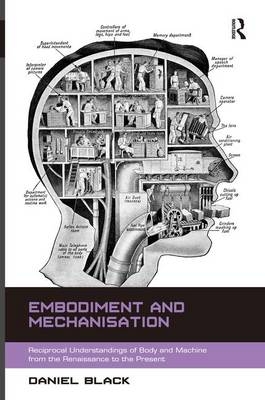
Embodiment and Mechanisation
Reciprocal Understandings of Body and Machine from the Renaissance to the Present
Seiten
2014
Routledge (Verlag)
978-1-4724-1543-1 (ISBN)
Routledge (Verlag)
978-1-4724-1543-1 (ISBN)
This book explores the interaction between mechanistic beliefs about human bodies and the successive technologies that have established and illustrated these beliefs.
Drawing on philosophical, neurological and cultural answers to the question of what constitutes a body, this book explores the interaction between mechanistic beliefs about human bodies and the successive technologies that have established and illustrated these beliefs. At the same time, it draws upon newer perspectives on technology and embodied human thought in order to highlight the limitations and inadequacies of such beliefs and suggest alternative perspectives. In so doing, it provides a position from which widely held assumptions about our relationship with technology can be understood and questioned, by both showing how these presuppositions have emerged and developed, and examining the extent to which they are dependent upon our grasp of specific technologies. Illustrated with examples from the Renaissance and Enlightenment periods, as well as the industrial age and the recent eras of informatics, gene science and nanotechnology, Embodiment and Mechanisation highlights the ways in which technological changes have led to shifts in the definition of machine and body, investigating their shared underlying belief that all matter can be reduced to a common substance. From clockwork and cadavers to engines and energy, this volume reveals our long-standing fascination with and enduring commitment to the idea that bodies are machines and that machines are in some sense bodies. As such, it will appeal to scholars across the humanities and social sciences with interests in the sociology of science and technology, embodiment, cultural studies and the history of ideas.
Drawing on philosophical, neurological and cultural answers to the question of what constitutes a body, this book explores the interaction between mechanistic beliefs about human bodies and the successive technologies that have established and illustrated these beliefs. At the same time, it draws upon newer perspectives on technology and embodied human thought in order to highlight the limitations and inadequacies of such beliefs and suggest alternative perspectives. In so doing, it provides a position from which widely held assumptions about our relationship with technology can be understood and questioned, by both showing how these presuppositions have emerged and developed, and examining the extent to which they are dependent upon our grasp of specific technologies. Illustrated with examples from the Renaissance and Enlightenment periods, as well as the industrial age and the recent eras of informatics, gene science and nanotechnology, Embodiment and Mechanisation highlights the ways in which technological changes have led to shifts in the definition of machine and body, investigating their shared underlying belief that all matter can be reduced to a common substance. From clockwork and cadavers to engines and energy, this volume reveals our long-standing fascination with and enduring commitment to the idea that bodies are machines and that machines are in some sense bodies. As such, it will appeal to scholars across the humanities and social sciences with interests in the sociology of science and technology, embodiment, cultural studies and the history of ideas.
Daniel Black is Lecturer in Communications and Media Studies at Monash University, Australia and co-editor of Complicated Currents: Media Flows, Soft Power and East Asia. He has published numerous book chapters and articles investigating our embodied relationship with technology, including publication in journals such as Body & Society and Theory, Culture & Society.
Introduction; Chapter 1 How to Look at Bodies; Chapter 2 Machina Carnis; Chapter 3 Android Dreams; Chapter 4 Informateriality; Chapter 5 An Aesthetics of the Invisible; Conclusion;
| Erscheint lt. Verlag | 1.5.2014 |
|---|---|
| Verlagsort | London |
| Sprache | englisch |
| Maße | 156 x 234 mm |
| Gewicht | 570 g |
| Themenwelt | Geisteswissenschaften ► Geschichte |
| Geisteswissenschaften ► Philosophie ► Philosophie der Neuzeit | |
| Studium ► 1. Studienabschnitt (Vorklinik) ► Med. Psychologie / Soziologie | |
| Sozialwissenschaften ► Ethnologie | |
| Sozialwissenschaften ► Soziologie ► Allgemeines / Lexika | |
| ISBN-10 | 1-4724-1543-4 / 1472415434 |
| ISBN-13 | 978-1-4724-1543-1 / 9781472415431 |
| Zustand | Neuware |
| Haben Sie eine Frage zum Produkt? |
Mehr entdecken
aus dem Bereich
aus dem Bereich


